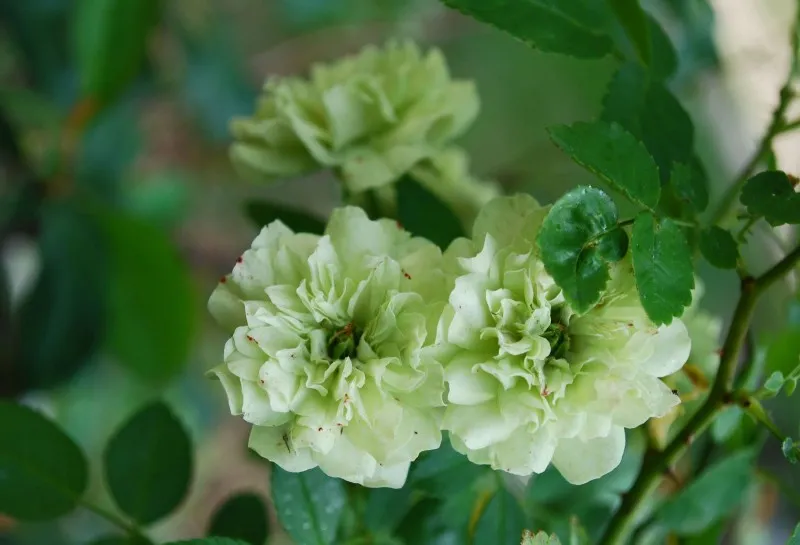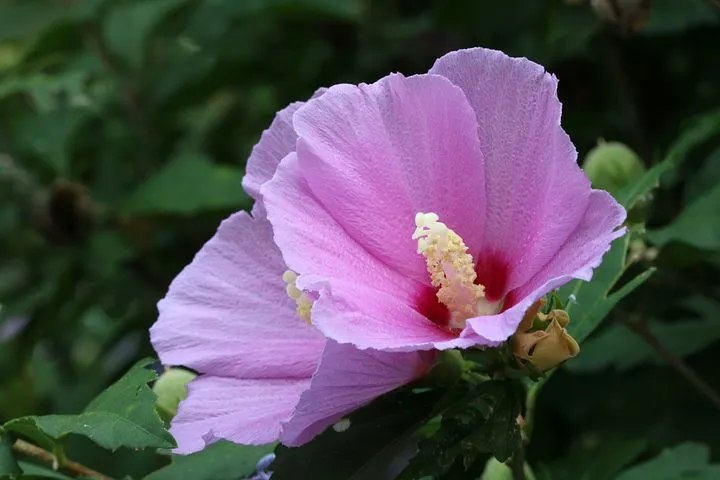How To Grow and Care Green Ice Rose

The green ice rose, known for its enchanting beauty and unique characteristics, is a favorite among gardeners and floral enthusiasts. This captivating rose stands out with its delicate green-tinted blooms and intricate foliage, offering a refreshing twist on the classic rose. Its charm lies not only in its visual appeal but also in its relatively easy care requirements, making it a popular choice for both novice and experienced gardeners.
Understanding Green Ice Rose

Origin and Natural Habitat
The green ice rose originates from selective breeding programs aimed at creating roses with unique colorations and hardy characteristics. While not a naturally occurring variety, its parent species can be traced back to temperate regions, where roses traditionally thrive. These regions provide the ideal conditions of moderate temperatures, well-draining soils, and sufficient sunlight.
Unique Characteristics
What sets the green ice rose apart from other rose varieties is its stunning green-tinged flowers. These blooms often start as pale green buds and gradually develop a more pronounced green hue as they mature. The leaves of the green ice rose are typically dark green and glossy, providing a striking contrast to the pastel blooms. This variety also tends to have a compact growth habit, making it suitable for small gardens and container planting.
Planting Green Ice Rose

Choosing the Right Spot
When deciding where to plant your green ice rose, consider both indoor and outdoor options. Outdoors, choose a spot that receives ample sunlight, ideally six to eight hours of direct sunlight daily. Indoors, place the plant near a south-facing window where it can get plenty of light. Ensure the spot is well-ventilated to prevent fungal diseases.
Soil Preparation
Preparing the soil is crucial for the successful growth of your green ice rose. The soil should be well-draining to prevent waterlogging, which can lead to root rot. A mix of garden soil, compost, and perlite or sand works well. Before planting, enrich the soil with organic matter such as compost or well-rotted manure to enhance its fertility and structure.
Planting Steps
- Choose the Right Time: The best time to plant green ice roses is in the spring or fall when the temperatures are moderate.
- Prepare the Planting Hole: Dig a hole that is twice as wide and as deep as the rose's root ball.
- Amend the Soil: Mix the excavated soil with compost or manure.
- Position the Plant: Place the rose in the hole, ensuring the root ball is level with the ground surface.
- Backfill the Hole: Fill the hole with the amended soil, pressing gently to eliminate air pockets.
- Water Thoroughly: Water the plant deeply to help it establish in its new location.
- Mulch: Apply a layer of mulch around the base of the plant to retain moisture and suppress weeds.
Green Ice Rose Care

Light
Green ice roses thrive in full sun, requiring at least six hours of direct sunlight each day. If grown indoors, place them near a bright, south-facing window. Supplement natural light with grow lights if necessary to ensure the plant gets enough light to bloom and thrive.
Soil
A well-draining soil mix is essential for green ice roses. A combination of garden soil, compost, and perlite or sand provides the ideal growing medium. This mix ensures good drainage while retaining enough moisture for the plant's needs. Regularly check the soil pH and aim for a slightly acidic to neutral range (pH 6.0 to 7.0).
Water
Watering frequency depends on the climate and soil conditions. Generally, water green ice roses deeply once a week, ensuring the soil remains moist but not waterlogged. In hotter climates or during dry spells, increase the watering frequency. Use a soaker hose or drip irrigation system to deliver water directly to the roots, minimizing water waste and reducing the risk of fungal diseases.
Temperature and Humidity
Green ice roses prefer moderate temperatures between 60-75°F (15-24°C). While they can tolerate some variation, extreme temperatures can stress the plant. Maintain a humidity level of around 50% to mimic their natural growing conditions. Use a humidity tray or a room humidifier if growing indoors to maintain adequate humidity levels.
Fertilizer
Feed green ice roses with a balanced rose fertilizer every 4-6 weeks during the growing season (spring and summer). Follow the manufacturer's instructions for the correct dosage. Alternatively, use organic options like compost tea or fish emulsion. Reduce feeding frequency during the fall and stop entirely in winter to allow the plant to rest.
Pruning
Pruning is essential for maintaining the shape and health of your green ice rose. Prune in late winter or early spring before new growth begins. Remove dead or diseased wood, and cut back any crossing branches to improve air circulation. Trim the plant to shape it and encourage vigorous growth and abundant blooms.
Popular Varieties of Green Ice Rose
List and Describe
- Green Ice Shrub Rose: Known for its compact growth and delicate green-tinged flowers, ideal for borders and containers.
- Mint Julep: Features larger blooms with a hint of mint green, suitable for garden beds and cut flower arrangements.
- Lime Sublime: Exhibits a more vibrant green hue, adding a unique splash of color to any garden.
- Emerald Isle: A variety with a slightly more robust growth habit, perfect for creating hedges or garden focal points.
You May Also Like: Easy Ways To Grow And Care Chinensis Rose
Propagating Green Ice Rose

Methods
- Cuttings: Take 6-8 inch cuttings from healthy, mature plants. Dip the cut ends in rooting hormone and plant in a well-draining soil mix.
- Layering: Bend a low-growing branch to the ground and cover it with soil, leaving the tip exposed. Once roots develop, sever the new plant from the parent.
- Division: Carefully dig up the plant and separate the roots into smaller sections, each with its own set of roots and shoots. Replant immediately.
From my experience, using cuttings has been the most successful propagation method. Ensure the cuttings are taken from healthy, disease-free plants, and maintain high humidity around the cuttings until they root. Using a rooting hormone can significantly increase the success rate.
Potting and Repotting
Choosing the Right Pot
Select a pot that is at least 12 inches in diameter with drainage holes to prevent waterlogging. Terracotta pots are ideal as they allow the soil to breathe, but plastic or ceramic pots work well too if proper drainage is ensured.
Repotting Steps
- Timing: Repot green ice roses in early spring before new growth begins.
- Prepare the New Pot: Fill the bottom with a layer of gravel for drainage, then add a suitable soil mix.
- Remove the Plant: Carefully remove the plant from its current pot, gently shaking off excess soil.
- Inspect the Roots: Trim any damaged or overly long roots.
- Position in New Pot: Place the plant in the new pot, filling around the roots with soil.
- Water Thoroughly: Water well to settle the soil and remove air pockets.
- Mulch: Apply a layer of mulch to retain moisture.
Common Pests & Plant Diseases

Pest Identification
- Aphids: Small, green or black insects that cluster on new growth and buds.
- Spider Mites: Tiny, red or yellow mites that create fine webs and cause stippling on leaves.
- Rose Slugs: Larvae that skeletonize leaves, leaving a lacy appearance.
Disease Identification
- Black Spot: Fungal disease causing black spots on leaves, leading to yellowing and drop.
- Powdery Mildew: White, powdery fungal growth on leaves and stems.
- Rust: Orange or yellow pustules on the undersides of leaves.
Treatment and Prevention
- Aphids: Spray with insecticidal soap or neem oil. Introduce beneficial insects like ladybugs.
- Spider Mites: Increase humidity and spray with miticides or insecticidal soap.
- Rose Slugs: Handpick or use horticultural oil sprays.
For fungal diseases:
- Black Spot: Remove and destroy affected leaves. Apply fungicides and improve air circulation.
- Powdery Mildew: Remove infected parts and apply fungicides.
- Rust: Remove affected leaves and use fungicidal sprays.
Troubleshooting Common Problems

Poor Flowering
Causes: Insufficient light, poor soil, inadequate nutrients, or incorrect pruning. Solutions: Ensure the plant receives enough light, improve soil quality with compost, fertilize regularly, and prune correctly.
Yellowing Leaves
Causes: Overwatering, nutrient deficiency, or disease. Solutions: Check soil moisture and reduce watering if necessary, apply a balanced fertilizer, and treat for diseases if present.
Stunted Growth
Causes: Poor soil, lack of nutrients, or pest infestation. Solutions: Improve soil quality, fertilize appropriately, and inspect for pests.
Fungal Infections
Identification: Spots, mildew, or rust on leaves and stems. Treatment: Remove affected parts, improve air circulation, and apply fungicides.
Seasonal Care Tips
Spring and Summer
- Watering: Increase watering frequency as temperatures rise.
- Fertilizing: Feed with a balanced fertilizer every 4-6 weeks.
- Pruning: Perform light pruning to shape the plant and remove spent blooms.
- Pest Control: Monitor for pests and treat promptly.
Fall and Winter
- Watering: Reduce watering frequency as growth slows.
- Fertilizing: Stop fertilizing to allow the plant to enter dormancy.
- Pruning: Prune heavily in late winter to prepare for spring growth.
- Protection: Mulch around the base to protect roots from freezing temperatures.
Conclusion
The green ice rose is a stunning and unique variety that offers a fresh take on traditional roses. With its delicate green blooms and relatively easy care requirements, it can be a delightful addition to any garden or indoor space. By understanding its needs and providing proper care, you can enjoy the beauty of the green ice rose year-round. Share your experiences and tips with fellow gardeners to foster a community of green ice rose enthusiasts.





